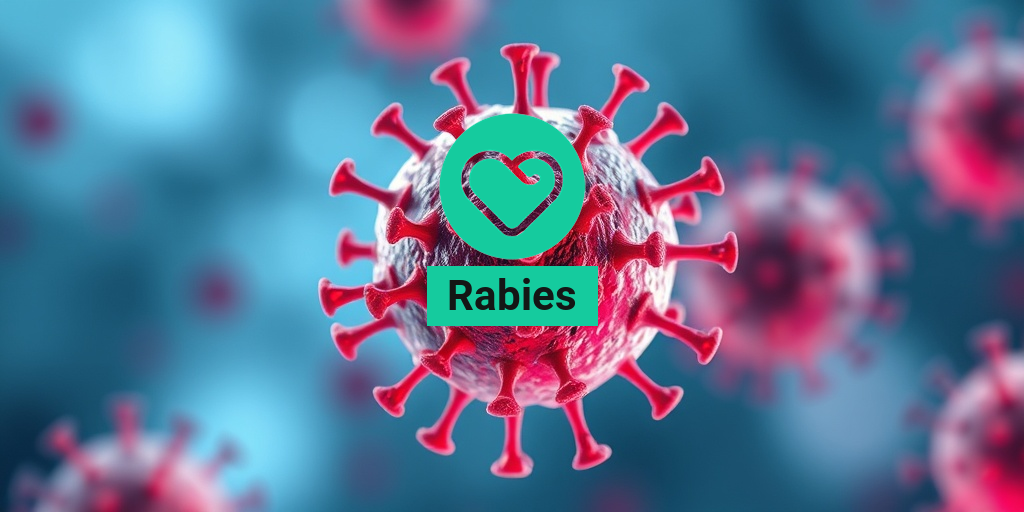What Is Rabies?
Rabies is a viral disease that primarily affects mammals, including humans. It is caused by the rabies virus, which is a member of the Lyssavirus genus. This disease is notorious for its severe neurological effects and is almost always fatal once symptoms appear. Understanding rabies is crucial, especially for those who may be at risk due to exposure to potentially infected animals.
Transmission of Rabies
The rabies virus is typically transmitted through the saliva of an infected animal via bites or scratches. Common carriers of the virus include:
- Dogs 🐕
- Cats 🐈
- Bats 🦇
- Raccoons 🦝
- Foxes 🦊
In many parts of the world, particularly in developing countries, rabies is a significant public health concern due to the high number of stray dogs. In contrast, in developed countries, rabies is more commonly associated with wildlife.
Global Impact of Rabies
According to the World Health Organization (WHO), rabies causes approximately 59,000 deaths each year, with the majority occurring in Asia and Africa. The disease is preventable through vaccination, yet many people remain unaware of its seriousness and the necessary precautions to take.
Rabies Symptoms
Recognizing the symptoms of rabies is vital for timely intervention. The incubation period for rabies can vary, typically ranging from a few weeks to several months, depending on the location of the bite and the amount of virus introduced into the body. Early symptoms can be quite vague and may resemble those of the flu.
Early Symptoms
In the initial stages, individuals may experience:
- Fever 🌡️
- Headache 🤕
- Weakness or discomfort
- Itching or prickling sensation at the site of the bite
Progression of Symptoms
As the disease progresses, more severe symptoms may develop, including:
- Confusion or agitation
- Hallucinations 👀
- Difficulty swallowing, leading to hydrophobia (fear of water)
- Paralysis or muscle spasms
- Coma
Once these symptoms appear, rabies is almost always fatal, making early recognition and treatment critical. If you suspect you have been exposed to rabies, it is essential to seek medical attention immediately.
Preventive Measures
Preventing rabies is primarily about avoiding exposure to potentially infected animals. Here are some key preventive measures:
- Vaccinate pets against rabies 🐾
- Avoid contact with wild animals
- Report stray animals to local authorities
- Educate yourself and others about rabies and its transmission
In case of a bite or scratch from an animal that may be rabid, it is crucial to wash the wound thoroughly with soap and water and seek medical attention immediately. A rabies vaccine can be administered to prevent the onset of the disease if given promptly.
For more information on rabies and other health-related topics, consider visiting Yesil Health AI, a valuable resource for evidence-based health answers.
In conclusion, rabies is a serious disease that requires awareness and preventive measures. By understanding what rabies is and recognizing its symptoms, you can take the necessary steps to protect yourself and your loved ones. Stay informed, stay safe! 🌍

Rabies Transmission
Rabies is a viral disease that primarily affects mammals, including humans. Understanding how rabies is transmitted is crucial for prevention and control. The rabies virus is typically spread through the saliva of an infected animal, most commonly via bites. Here’s a closer look at the various modes of transmission:
1. Animal Bites
The most common way rabies is transmitted is through bites from infected animals. When an infected animal bites another animal or a human, the virus can enter the body through the broken skin. This is why it’s essential to seek medical attention immediately after a bite from a potentially rabid animal.
2. Scratches and Open Wounds
While bites are the primary mode of transmission, rabies can also be transmitted through scratches or open wounds that come into contact with the saliva of an infected animal. This highlights the importance of avoiding contact with wild animals, especially those that exhibit unusual behavior.
3. Inhalation of Aerosolized Virus
Though rare, rabies can also be transmitted through inhalation of aerosolized virus particles. This is more likely to occur in specific environments, such as bat caves, where the virus can be present in the air. However, this mode of transmission is not common in everyday situations.
4. Organ Transplants
There have been documented cases of rabies transmission through organ transplants from infected donors. This underscores the importance of screening potential organ donors for rabies, especially in areas where the disease is prevalent.
5. Non-Bite Exposures
In very rare cases, rabies can be transmitted through non-bite exposures, such as when saliva from an infected animal comes into contact with mucous membranes (like the eyes, nose, or mouth). While these instances are uncommon, they serve as a reminder to exercise caution around potentially rabid animals.
Rabies Risk Factors
Understanding the risk factors associated with rabies can help individuals take proactive measures to protect themselves and their communities. Here are some key risk factors to consider:
1. Geographic Location
Rabies is more prevalent in certain regions, particularly in parts of Africa, Asia, and Central and South America. In these areas, the risk of encountering rabid animals is significantly higher. Travelers to these regions should be aware of the local rabies situation and take necessary precautions.
2. Animal Exposure
Individuals who work with animals, such as veterinarians, animal control officers, and wildlife rehabilitators, are at a higher risk of rabies exposure. It’s essential for these professionals to receive rabies vaccinations and follow safety protocols to minimize their risk.
3. Unvaccinated Pets
Pets that are not vaccinated against rabies pose a risk to their owners and the community. Ensuring that pets receive their rabies vaccinations is a critical step in preventing the spread of the virus. Regular veterinary check-ups can help keep pets protected.
4. Wild Animal Encounters
Encounters with wild animals, particularly bats, raccoons, skunks, and foxes, increase the risk of rabies transmission. It’s important to avoid contact with wild animals and to educate children about the dangers of approaching unfamiliar animals.
5. Lack of Awareness
A lack of awareness about rabies and its transmission can lead to increased risk. Education about the disease, its symptoms, and preventive measures is vital for communities, especially in areas where rabies is endemic. Awareness campaigns can help inform the public about the importance of vaccination and responsible pet ownership.
By understanding the transmission methods and risk factors associated with rabies, individuals can take informed steps to protect themselves and their loved ones. Remember, prevention is always better than cure! 🐾

Rabies Diagnosis
Rabies is a viral disease that affects the central nervous system, leading to severe neurological symptoms and, ultimately, death if left untreated. Early diagnosis is crucial for effective management and treatment. Understanding how rabies is diagnosed can help individuals recognize the signs and seek timely medical attention.
Recognizing Symptoms
The first step in diagnosing rabies involves recognizing its symptoms. Rabies symptoms can vary, but they typically appear within one to three months after exposure to the virus. Early symptoms may include:
- Fever
- Headache
- Weakness or discomfort
- Insomnia
- Anxiety
As the disease progresses, more severe symptoms may develop, such as:
- Confusion
- Agitation
- Hallucinations
- Difficulty swallowing
- Hydrophobia (fear of water)
If you or someone you know has been bitten by an animal that may carry rabies, it’s essential to monitor for these symptoms closely. 🐾
Medical Evaluation
If rabies is suspected, a healthcare professional will conduct a thorough medical evaluation. This may include:
- Patient History: The doctor will ask about any recent animal bites or exposure to potentially rabid animals.
- Physical Examination: A physical exam will help assess neurological function and identify any symptoms indicative of rabies.
Laboratory Tests
While there is no single test for rabies, several laboratory tests can aid in diagnosis:
- Saliva Tests: Samples of saliva may be tested for the presence of the rabies virus.
- Cerebrospinal Fluid (CSF) Analysis: A lumbar puncture may be performed to analyze the CSF for viral presence.
- Skin Biopsy: A skin biopsy from the nape of the neck can be examined for rabies antigen.
It’s important to note that rabies is often diagnosed post-mortem, as definitive tests can only be performed on brain tissue. Therefore, seeking immediate medical attention after a potential exposure is vital. ⏳
Rabies Treatment Options
Once diagnosed, the treatment options for rabies depend on the stage of the disease. Unfortunately, rabies is almost always fatal once clinical symptoms appear. However, there are preventive measures and treatments available for those who have been exposed to the virus.
Post-Exposure Prophylaxis (PEP)
The most effective way to prevent rabies after exposure is through Post-Exposure Prophylaxis (PEP). This treatment involves a series of rabies vaccinations and, in some cases, rabies immune globulin (RIG). Here’s how it works:
- Rabies Vaccine: A series of rabies vaccinations is administered to stimulate the immune system to fight off the virus.
- Rabies Immune Globulin (RIG): This is given in cases of high-risk exposure to provide immediate passive immunity.
PEP is most effective when administered as soon as possible after exposure, ideally within 24 hours. 🕒
Supportive Care
For individuals who develop rabies symptoms, treatment focuses on supportive care. This may include:
- Hospitalization: Patients may require hospitalization for monitoring and supportive treatment.
- Pain Management: Medications may be prescribed to manage pain and discomfort.
- Respiratory Support: In severe cases, mechanical ventilation may be necessary.
Unfortunately, once symptoms appear, the prognosis is poor, and treatment is primarily palliative. Therefore, prevention through vaccination and immediate medical attention after potential exposure is crucial.
Vaccination for Pets
Preventing rabies in pets is essential to reducing the risk of transmission to humans. Vaccinating dogs, cats, and other pets against rabies is a critical public health measure. Regular vaccination schedules should be followed to ensure pets remain protected. 🐶🐱
In summary, understanding the diagnosis and treatment options for rabies is vital for prevention and management. If you suspect exposure to rabies, seek medical attention immediately to ensure the best possible outcome.

Rabies Prevention Strategies
Rabies is a viral disease that poses a significant threat to both humans and animals. Understanding how to prevent rabies is crucial for public health and safety. Here are some effective prevention strategies that can help reduce the risk of rabies transmission.
Vaccination
The most effective way to prevent rabies is through vaccination. Vaccines are available for both humans and animals. Here’s how vaccination plays a vital role:
- For Humans: If you are at high risk of exposure (such as veterinarians or animal control officers), getting a rabies vaccine before potential exposure can provide immunity.
- For Pets: Ensure that your pets are vaccinated against rabies. This is not only a legal requirement in many areas but also a critical step in protecting your furry friends and yourself.
Avoiding Wild Animals
Wild animals are often carriers of the rabies virus. To minimize your risk:
- Do not approach or handle wild animals: This includes raccoons, bats, and foxes, which are known to be common carriers.
- Secure your trash: Keep garbage cans tightly closed to avoid attracting wild animals to your property.
Educating the Community
Community education is essential in preventing rabies. Here are some ways to spread awareness:
- Organize vaccination drives: Collaborate with local veterinarians to offer free or low-cost rabies vaccinations for pets.
- Host informational sessions: Teach community members about the signs of rabies and the importance of vaccination.
Immediate Action After Exposure
If you are bitten or scratched by an animal, it’s crucial to act quickly:
- Wash the wound: Clean the bite area thoroughly with soap and water for at least 15 minutes.
- Seek medical attention: Visit a healthcare provider immediately to discuss the need for a rabies shot.
Rabies in Animals
Rabies is not just a human concern; it significantly affects animals as well. Understanding how rabies manifests in animals can help in early detection and prevention.
Common Carriers of Rabies
Various animals can carry the rabies virus, but some are more common than others:
- Dogs: In many parts of the world, unvaccinated dogs are the primary source of rabies transmission to humans.
- Bats: These flying mammals are significant carriers of rabies, especially in North America.
- Raccoons and Foxes: These animals are also known to spread rabies, particularly in urban areas.
Symptoms of Rabies in Animals
Recognizing the symptoms of rabies in animals is crucial for early intervention. Common signs include:
- Behavioral changes: Animals may become unusually aggressive or overly friendly.
- Excessive drooling: This is often due to difficulty swallowing.
- Seizures: Neurological symptoms can manifest as seizures or paralysis.
Importance of Reporting
If you suspect an animal may have rabies, it’s essential to report it to local animal control or health authorities. Early reporting can help prevent the spread of the virus and protect both human and animal populations.
By implementing these prevention strategies and understanding the impact of rabies in animals, we can work together to reduce the risk of this deadly disease. 🐾💉

Frequently Asked Questions about Rabies
What is rabies?
Rabies is a viral disease that affects the central nervous system, leading to brain inflammation and, if untreated, can be fatal. It is primarily transmitted through the bite of an infected animal.
What are the symptoms of rabies?
The symptoms of rabies can vary but typically include:
- Fever
- Headache
- Confusion or agitation
- Hydrophobia (fear of water)
- Paralysis
- Hallucinations
How is rabies transmitted?
Rabies is mainly transmitted through the saliva of infected animals, usually via bites. Common carriers include bats, raccoons, foxes, and domestic animals like dogs and cats.
Can rabies be prevented?
Yes, rabies can be prevented through vaccination. The rabies vaccine is effective for both humans and animals. It is crucial to vaccinate pets and avoid contact with wild animals.
What should I do if I am bitten by an animal?
If you are bitten by an animal, it is essential to:
- Wash the wound thoroughly with soap and water.
- Seek medical attention immediately.
- Discuss the need for a rabies shot with your healthcare provider.
Is rabies treatable once symptoms appear?
What is the rabies vaccine schedule?
The rabies vaccine schedule typically involves a series of shots administered over a few weeks. It is crucial to follow your healthcare provider’s recommendations for the best protection.
Can rabies affect humans?
Yes, rabies in humans can occur if a person is bitten by an infected animal. It is vital to seek immediate medical care to prevent the disease from progressing.
What is the meaning of rabies in different languages?
In German, rabies is referred to as “Tollwut.” Understanding the terminology can be helpful when discussing the disease in various contexts.
Where is rabies most common?
Rabies is prevalent in many parts of the world, particularly in regions with high populations of unvaccinated stray animals. It is essential to be cautious in areas where the disease is known to occur.
How can I protect my pets from rabies?
To protect your pets from rabies, ensure they are vaccinated regularly, avoid letting them roam freely, and keep them away from wild animals.




